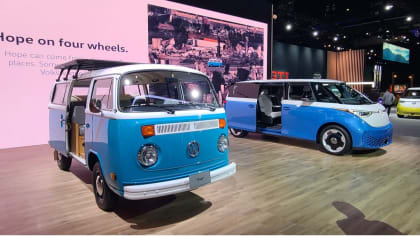SONATAS IN E MAJOR
2016 Hyundai Sonata Hybrid & Plug-In Hybrid
This article is from our archives and has not been updated and integrated with our "new" site yet... Even so, it's still awesome - so keep reading!
Published on Fri, Aug 7, 2015
By: The LACar Editorial Staff

By Reed Berry
I’m spending some time with the twins. They’re not identical twins, however. While similar in appearance, there are certain differences that give each its own individual personality. It wouldn’t be fair to neglect either of them, so I’ll divide my time equally during a scenic drive from Orange County to La Jolla and back. The twins I’m referring to are the 2016 Hyundai Sonata Hybrid and Sonata Plug-In Hybrid.
Millions of drivers have already taken to the streets in hybrid vehicles while others are still trying to wrap their heads around the concept as they decide whether to stick with gas engines, graduate to a hybrid or wait for the rollout of hydrogen fuel cell vehicles. But, whether you think of it as “going green,” “eco-friendly” or “guilt-free” fuel-efficient driving, hybrid technology is gaining in popularity and, of course, Hyundai has wrapped it all up in a very attractive package.
I use the words “of course” because over the last several years, Hyundai has attracted much attention (and sold millions of cars) by producing vehicles with major eye appeal. Their “fluidic sculpture” design has turned what used to be boxy transportation cars into sleek, stylish vehicles that definitely turn heads. The new 2016 models are certainly no exception. From front to back, the attention to detail is apparent in both vehicles I’ll be driving during today’s coastal road test.
The front and rear fascia of this second-generation Sonata Hybrid have been designed to improve aerodynamics while highlighting the car’s efficiency, reducing the coefficient of drag, according to Hyundai, to an extremely low and quite impressive 0.24, the lowest in its class. Other design changes include a larger grille, distinctive front and rear bumpers and chrome side sill moldings, as well as an eco-spoke alloy wheel design that further adds to the vehicle’s efficiency.

Sonata Hybrid has a comfortable, intelligently designed interior. Premium cloth seats come standard in the Hybrid, while owners of the Hybrid Limited will be treated to perforated leather seating with front seats that are heated and ventilated, as well as a leather-wrapped steering wheel and shift knob. Multimedia features include the usual offerings found in newer vehicles, such as AM / FM / Satellite Radio, CD player, plus iPod and Bluetooth connectivity.
For an even more entertaining experience, pop an extra $4,500 for the Ultimate Package that features, in addition to a variety of cool safety features and a panoramic sunroof, an 8-inch touch screen navigation system and premium audio system that supports Pandora and SoundHound. You can also record SiriusXM presets 1 through 6, allowing you to “rewind” up to 22 minutes of programming.
Cargo space in the Sonata Hybrid is an impressive 13.3 cubic feet, achieved by cleverly mounting the battery pack under the trunk floor. A standard Sonata without a bulky battery pack offers just 3 more cubic feet of cargo space, so it seems as though designers made the most of maximizing space and efficiency in the Sonata Hybrid. The Smart Trunk feature allows you to open the trunk hands-free by simply standing behind the vehicle for three seconds with the proximity key in your pocket or purse. Doors are to be locked and you must be within three feet of the vehicle for this handy feature to operate.
Under the hood, a downsized 2.0-liter Nu GDI four-cylinder engine is paired with a six-speed automatic transmission that houses a more powerful 38 kW electric motor and clutch where the torque converter would normally be found. Sonata Hybrid’s Nu engine produces 154 horsepower and 140 lb. ft. of torque. The electric motor produces 38 kW (51 horsepower) and 151 lb. ft. of torque. Hybrid system net power is 193 horsepower at 6,000 rpm. The transition from the electric motor to the gas engine is so smooth that it is barely noticeable.

The car handles exceptionally well. Steering is responsive and the ride is comfortable while still providing a good feel of the road. The car is equipped with MacPherson struts on the front and independent rear suspension for solid performance. For a more personalized driving experience, you can select from three drive modes: Eco, Normal or Sport. Braking is fairly efficient and the vehicle’s anti-lock braking system allows me to stop quickly and confidently.
The Sonata Hybrid and Hybrid Limited both come nicely equipped with a variety of standard features, including a back-up camera, dual automatic climate control, cabin air filter and steering wheel mounted audio and phone controls. What they don’t have is a spare tire. Many automakers, including Hyundai, have ditched the spare in favor of an emergency tire mending kit on some of their models. Call me old fashioned, but I prefer a spare tire to a tire mending experience.
Following a quick lunch in La Jolla, I get behind the wheel of the Sonata Plug-In Hybrid and start my journey back to Orange County. It doesn’t really seem as though I’m in a different vehicle. Just like the Sonata Hybrid, the Plug-In Hybrid has a spacious, neatly appointed interior. Seating is comfortable and all buttons and controls are conveniently placed. The interior has a sleek, contemporary appearance without being overly sporty or luxurious.
The real difference between the vehicles is the way in which they operate. While the driving dynamics of both cars are fairly similar, the Plug-In hybrid can travel up to 24 miles on electric power and recharges fairly quickly. Using a 240-volt Level 2 charger (the electric vehicle charging stations you see in the parking lots of shopping malls and office buildings) you can charge the vehicle in under three hours. With a 120-volt Level 1 charger that you plug into a standard AC outlet, the vehicle will charge in under nine hours.

Once the battery charge is depleted, the Plug-In Hybrid performs pretty much like the Sonata Hybrid so there is no need to make a mad dash to the nearest charging station. The Plug-In Hybrid has many of the same features of the Sonata Hybrid as well, with a couple of noticeable exceptions. An eight-inch screen displays energy flow and Eco driving information. As for selectable drive modes, the Plug-In Hybrid offers a choice of Eco or Normal. The Sport mode present in the Sonata Hybrid is not available in the Plug-In Hybrid.
One of the coolest features of the Plug-In Hybrid is Hyundai’s Blue Link smartphone app that allows the owner to give the vehicle specific commands, such as to unlock the doors or start the engine. You can also access real-time data from the vehicle, including vehicle diagnostics, battery level and charge status. The app also allows you to set up and manage a convenient charging schedule for the vehicle.
Due to a larger battery pack, the generous cargo area I enjoyed in the Sonata Hybrid is reduced to 9.9 cubic feet in the Plug-In Hybrid. Yes, a significant decrease in cargo volume, but still spacious enough to hold a few suitcases or several bags of groceries. And, needless to say, reduced cargo space is a small price to pay for the benefit you will receive from driving such an eco-friendly vehicle.
While some drivers may just think of them as a bunch of annoying flashing lights and audible tones, Hyundai has loaded this vehicle with some really helpful features to make our drive a little safer, as well as enhancing safety for those around us. Blind Spot Detection alerts the driver to approaching vehicles in an adjacent lane when the turn signal is activated. Rear Cross-Traffic Alert gives an audible signal when a car approaches from either side while you are backing.

Perhaps one of the most interesting – and possibly important – safety features is the Virtual Engine Sound System. When running in electric-only mode, hybrids are practically silent and, as a result, pedestrians may not even realize there are vehicles approaching. At low speeds, Hyundai’s VESS generates a virtual engine sound similar to that of a conventional internal combustion engine.
Another feature I particularly enjoy is Hyundai’s Smart Cruise Control. Although it initially takes a little getting used to, it certainly makes life – and driving – much easier. Gone are the days when cruise control only worked while you were indeed cruising, only to disengage when hitting the brakes as traffic slowed ahead. With adaptive cruise control, simply set the desired speed and the vehicle will maintain that speed but will decelerate and accelerate automatically as the speed of the vehicle in front of you changes.
The Sonata Hybrid is arriving in Hyundai showrooms this summer. The Plug-In Hybrid will roll into showrooms later this year in the following states: California, Connecticut, Maine, Maryland, Massachusetts, New Jersey, New York, Oregon, Rhode Island and Vermont. Plug-In Hybrid owners will be eligible for some rather enticing federal tax credits, plus California owners will benefit from an additional $1,500 clean vehicle rebate as well as qualifying for the Green Clean Air Vehicle stickers that allow access to the HOV (carpool) lanes.
For more information on Hyundai products: www.hyundaiusa.com




